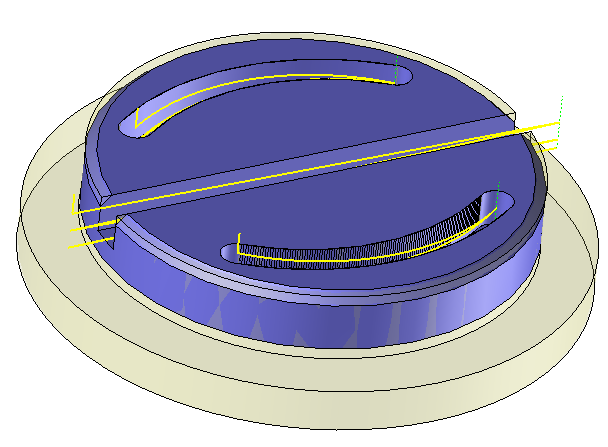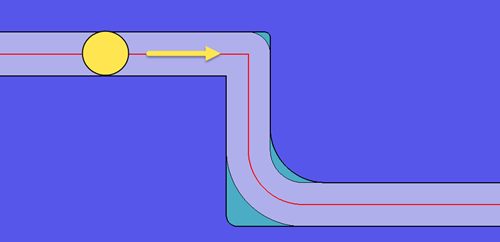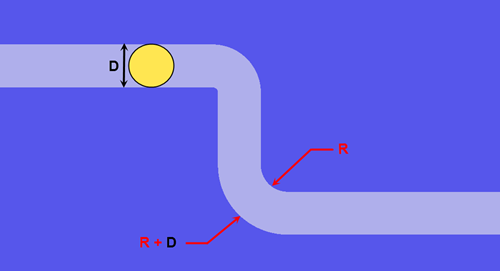
Slot Milling
|
Slot Milling |
Perform slot milling using a series of back and forth movements while plunging the material.
The plunge strategy can be set by the user. TopSolid'Cam recommends a number of Z passes based on the material to remove and the cutting conditions of the called tool.
Slope Cycle |
ZigZag Cycle |
Square Cycle |
|
|
|
![]() This function allows you to perform finer slot milling, where only one pass in the direction of the width is sufficient (in this case, the width of the slot determines the diameter value of the tool to use). However, it also allows you to perform the roughing of fine slots as long as a complete milling process is included.
This function allows you to perform finer slot milling, where only one pass in the direction of the width is sufficient (in this case, the width of the slot determines the diameter value of the tool to use). However, it also allows you to perform the roughing of fine slots as long as a complete milling process is included.

The use of a sketch allows the presence in the geometry of sharp angles or corners with a radius smaller than the tool radius.
On this case, TopSolid'Cam can so generate residual material that will be automatically recognized by material left operations.
 |
The use of topology (by clicking the groove bottom face) doesn't allow to use sharp angles on sides.
The external radius must be equal to the internal radius "R" plus the tool diameter "D" so TopSolid can calculate the groove middle profile.
 |
 Using the topology implies that there is not undercut on groove vertical faces.
Using the topology implies that there is not undercut on groove vertical faces.
When configuring milling settings in dialog boxes, the actual machinable area is viewed by interactive hatching.
A slot milling operation assumes a plunge in the material! Several completion modes are available, based on the tool selected by the operator.
From the 2D/3D menu, select Slot Milling or using the mouse (selecting a horizontal face with the right mouse button), select Other / Slot Milling.
A toolbar appears on the left of the screen, along with a label in the graphic area.
Select the tool for performing the operation.
![]() By default, TopSolid'Cam selects the previously used tool if no filters are created so that the diameter is less than or equal to the supposed width of the slot.
By default, TopSolid'Cam selects the previously used tool if no filters are created so that the diameter is less than or equal to the supposed width of the slot.
The user may wish to perform slot milling without a horizontal face (in the case of a slot with no bottom). In this case, by clicking one of the mounting faces representing a vertical fillet, you will not be able to select a planar vertical face. In this scenario, the operator must first create a sketch that defines the trajectory of the tool.
A preview of the milling area is represented by orange hatchings and the gray arrows on the trajectory allow you to reverse the milling direction of the first pass.

You can then modify values by
By selecting the value to modify in the label. The label is the table shown in the image in the top right corner. All label values are fields available from one of the icons in the left section. These values are placed on the label for quicker access.
By selecting the values in the graphic area or by pulling the arrows (the 2 fields have a value of 0.5 in the top image, above the hatching area). As with the values of the labels, these fields are present in one of the left section icons. These values are placed in the graphic area for quicker access.
By opening one of the left section icons.
|
Select Favorite
Instead of modifying n values, this option allows you to restore (or save) values that have already been entered.
|
|
Select the tool to use
By default, if the previous operation tool can be used, it is reused for this operation (the name of the tool appears in the graphic area next to
If the previous tool is not suitable or if this is the first operation, you must select a tool to validate the operation (
|
|
Define Cutting Conditions for Operation
Use this icon to modify the cutting conditions of the current operation.
|
|
Define or Add Geometries to Machine
Use this icon to select (or remove) machinable geometries. This geometry is automatically added, by first selecting the geometry and right-clicking "End Milling". You do not have to access the icon to do this.
Define Milling Boundaries
You can also apply trims (XYZ or contour) to the current operation.
|
|
Define All Milling Settings
Each milling has specific settings. Use this icon to access all settings (such as stocks to leave, altitudes, plunge modes, milling modes, etc.)
|
|
Define ISO File Settings
Use this icon to define which comment to use for the ISO code or to decide which inclined plane matrices to use.
|
|
Define colinear axis
This icon is available only if the current machine has colinear axis.With this icon it will then be possible to choose the axis drives by the operation.We also can choose the Z value of the fix axis.
|
|
Allow us to add one or more axis on the current machining
For example on 4 and 5 axis machine, to have the possibility of doing radial or axial operations. |
|
Define Operation Properties
Use this icon to define whether you would like to update the stock or calculate the result later.
|
|
Confirm
To confirm the current operation, pressing this icon to right-click outside the window and use the "OK" menu
|
|
Cancel
If you wish to cancel the operation, click this icon.
|
|
Preview
Display or hide the machining area. When this is hidden, this area is not calculated, and response times improve.
|
|
Show Label
Allows you to display or hide the graphic area label.
|
|
Editing Update
Each time a setting is changed (such as the axial depth), all calculations for updating the hatching area and the trajectory are triggered. The setting change may take a few moments. In several cases, settings must be modified before updating the calculations. For this, press this icon. In the case, the hatching area and trajectory (for example) are not recalculated before pressing this icon again.
|
![]() Click the different areas in the image below
Click the different areas in the image below ![]()
#1 |
|
Time |
00.00.20 |
Altitude... |
|
Stock to leave on floor |
|
Maximum Axial Depth |
|
Final Axial Depth |
|
Trajectory Preview |
![]() Visibility management when editing the operation: click on the icons below
Visibility management when editing the operation: click on the icons below![]()
Machine visibility |
WCS visibility |
Tool visibility |
Collision visibility |
Stock and finish visibility |
Tool paths visibility |
|
|
|
|
|